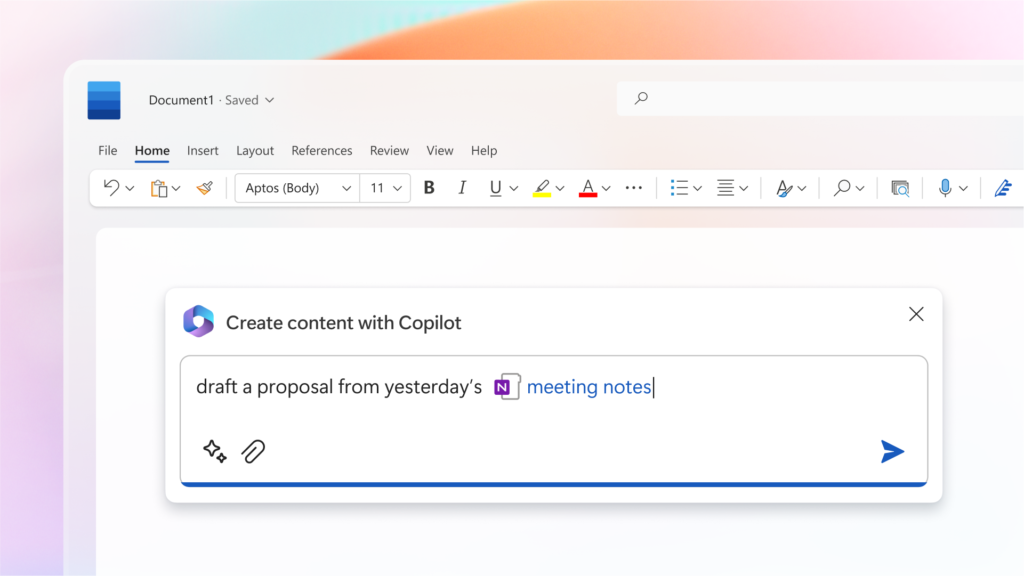You’ve likely heard about AI non-stop. It’s everywhere, from ChatGPT to Google Bard, to dear-old Microsoft Clippy. If your business is running on Microsoft’s Office, Dynamics, or Cloud products, then Microsoft’s Copilot AI is going to blow you away. With millions of businesses using Microsoft products around the world, let’s explore the difference between Copilot vs ChatGPT.
Although Microsoft Copilot is still in the early days, we want to show you 6 factors to consider that will help you understand how to use Copilot, and what real benefits your business can gain.
Six things to consider about Copilot vs ChatGPT and the Power of AI
- It’s not “available” yet.
Copilot was launched in March 2023 but only a select number of large enterprise clients got early paid access. From the videos and documentation Microsoft has released, the features look extremely promising for many business scenarios.
In June 2023, Microsoft announced they have expanded availability to a select 600 companies, with a general release announced for November 1, 2023.
- Copilot vs ChatGPT
Best way to describe what Microsoft Copilot can do is calling it “ChatGPT times 100.” Microsoft has invested over $10 billion into OpenAI – the maker of ChatGPT. This relationship has allowed Microsoft and OpenAI to work together on developing ChatGPT and Microsoft Copilot functionality.
In addition, Microsoft is the exclusive provider of ChatGPT’s backend infrastructure, products, and programming interfaces on its Azure platform. Essentially, with Copilot vs ChatGPT, you’re getting an advanced version of the OpenAI tool.

- Copilot will be everywhere.
Microsoft plans to make Copilot AI front and center. It will be easily accessible and prominent throughout Microsoft’s suite of cloud products, including Microsoft 365, Dynamics 365, Azure, GitHub, Windows, and Bing.
Almost every screen will have a Copilot button to get help from its AI. This will launch a panel with the application that looks like a chat box. Start typing in your query or chose from predictive options to get going.

- Your investment in Copilot vs ChatGPT will save you time and money on resources.
Copilot AI capabilities in Microsoft products will allow you to save significant time on time consuming tasks. For example, in Word, Microsoft Copilot will create a proposal based on the notes you took in OneNote, customize it look like your previous proposals and even add in artwork or visuals.
If you want, it can take any document and convert that into a stylish PowerPoint, complete with new slides and speaker notes. Excel users can use it to analyze data in a spreadsheet and generate graphs and charts, list trends, apply colors based on scenarios. Teams and Dynamics users can leverage Copilot to listen to meetings and write up summary notes, create tasks and send out next steps emails.
For Copilot vs ChatGPT, the former will include several new features. You can expect your employees to be much more productive and freeing up time for revenue-generating activities. In some cases, you may find you can right-size your employee count.
Here’s a simple formula.
Let’s say Microsoft Copilot is $30/month/user. Your Employee makes $50/hr, and Copilot saves that person at least 5 hours of work in a month, then you just saved $2640 / per employee / year. Now imagine that across your whole company!
10 person team? Save $26,400 per year!
50 person team? Save $132,000 per year!
Scenario: Your sales team is working on a proposal and presentation for a high-value client. It typically takes 8-10 hours to write the proposal and create a presentation. With Microsoft Copilot, the AI system can examine a previous proposal and your prospect notes to write the proposal. It will also take those notes and any other document and create a presentation. Your sales team might only need 2 hours instead of 10, freeing up 8 hours for other sales activities.
Microsoft Copilot is like having an extra full-time employee that only costs $30/month!
- Copilot will keep learning and improving.
As is the case with any AI assistant, Copilot will need time to learn and improve based on what Microsoft users commonly request it to do. From creating better formulas in Excel, more natural sounding emails, a more polished proposal, to many other tasks – every time you ask it to perform these actions, it learns and improves.
All of this amounts to an efficient and effective assistant that’s attuned to your requirements and preferences.
- Copilot relies on your data accuracy and completeness
Microsoft Copilot uses a Large Language Model (LLM) which means it is drawing information from the web but also from your internal data sources (Emails, Dynamics database, Word docs, Excel, SharePoint, etc.) This allows it to personalize and respond in a manner that actually helps you. Although you may be thinking about privacy issues, the bigger issue may in fact be how accurate or complete your data sources. Copilot can only be as effective as your data is accurate and complete. If you are anticipating using Copilot, its best to start a data validation exercise to prepare.
Copilot AI is not something that’s just for the IT team. Its not just another product. It has the power to be a way of life and standard practice across your entire business. It will reduce costs, increase revenues, and grow profits.
Every business owner, and its staff, need to understand it. Otherwise, prepare to get left in the dust by any company that does embrace the way of generative AI.
Explore more details on Microsoft Copilot vs ChatGPT, what the tool has to offer and how 360 Visibility can help you maximize its ROI.



